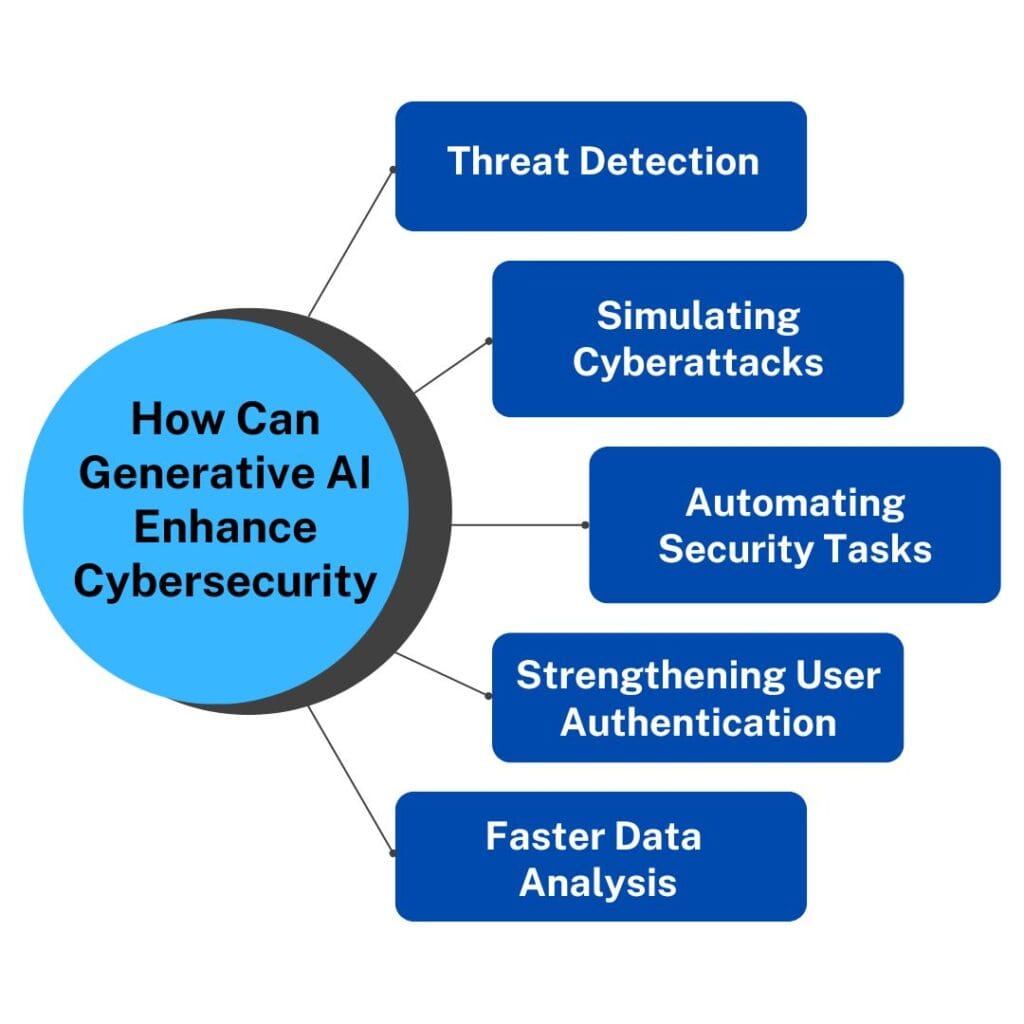Generative AI is transforming industries, including cybersecurity. But how can Generative AI be used in cybersecurity? Let’s explore its potential in protecting digital systems from threats.
Generative AI enhances cybersecurity by detecting threats, automating tasks, and simulating cyberattacks. It helps organizations secure data, identify risks faster, and strengthen defenses against hackers.
By combining Generative AI with traditional methods, organizations can stay ahead of cyber threats. Learn how this technology is shaping the future of cybersecurity and safeguarding digital systems.
Table of Contents
- What is Generative AI?
- Why Is Cybersecurity Important Today?
- How Can Generative AI Enhance Cybersecurity?
- Challenges and Risks of Using Generative AI in Cybersecurity
- Real-Life Examples of Generative AI in Cybersecurity
- Future of Generative AI in Cybersecurity
- Conclusion
What is Generative AI?
Generative AI is a type of artificial intelligence that creates new content, such as text, images, or even music, by learning patterns from existing data. It uses advanced algorithms like machine learning to understand and generate realistic outputs.
This technology doesn’t just copy data; it creates unique results based on what it has learned. For example, tools like ChatGPT can write essays, while DALL·E can create images from text prompts.
Generative AI is widely used in fields like healthcare, gaming, and now, cybersecurity. Its ability to generate realistic data makes it a powerful tool for solving complex problems.
Why Is Cybersecurity Important Today?
Cybersecurity is essential in protecting personal and business data from being stolen or misused. With most of our lives happening online, staying safe from cyber threats is crucial.
Common Cyber Threats
- Phishing Attacks: Fake emails or websites tricking users into sharing sensitive information.
- Ransomware: Hackers lock systems and demand money to release them.
- Data Breaches: Unauthorized access to sensitive information like passwords or financial data.
Why Strong Cybersecurity Matters
- Prevents Financial Loss: Cyberattacks can cost businesses and individuals millions.
- Protects Privacy: Ensures personal and professional data stays secure.
- Builds Trust: Businesses with strong cybersecurity gain customer confidence.
Traditional methods struggle to handle advanced threats. That’s why technologies like Generative AI are becoming key players in protecting digital systems.
How Can Generative AI Enhance Cybersecurity?
Generative AI is changing how we protect digital systems. It can detect threats, automate tasks, and even predict attacks before they happen, making cybersecurity stronger and smarter.
Key Ways Generative AI Enhances Cybersecurity

Here are the key ways generative AI enhances cybersecurity:
1. Threat Detection
- Generative AI analyzes large amounts of data to find unusual patterns.
- It can detect phishing emails, malware, or any suspicious activity in real time.
2. Simulating Cyberattacks
- AI can create fake cyberattacks to test system defenses.
- This helps organizations improve their security strategies before real threats occur.
3. Automating Security Tasks
- Repetitive tasks like scanning code for vulnerabilities can be automated.
- This saves time and reduces human errors.
4. Strengthening User Authentication
- Generative AI improves biometric security, such as facial or voice recognition.
- It generates unique identifiers, making it harder for hackers to break in.
5. Faster Data Analysis
- AI processes security logs faster than humans, identifying risks in seconds.
- This speeds up response times to potential threats.
By combining these capabilities, Generative AI helps organizations stay ahead of hackers and create stronger, more resilient cybersecurity systems.
Challenges and Risks of Using Generative AI in Cybersecurity
While Generative AI offers many benefits, it also comes with challenges and risks. Understanding these issues is essential for using AI responsibly in cybersecurity.
Challenges and Risks
Here are some challenges and risks of using Generative AI in cybersecurity:
1. AI Misuse by Hackers
- Hackers can use Generative AI to create advanced malware or phishing scams.
- It allows them to craft convincing fake emails, messages, or even voice mimics.
2. Data Privacy Concerns
- Generative AI often requires access to sensitive data for training.
- If not handled securely, this data could be exposed or misused.
3. Over-Reliance on AI
- Relying too much on AI might lead to neglecting human oversight.
- If AI makes a mistake, it could lead to serious security breaches.
4. High Costs and Complexity
- Implementing Generative AI tools can be expensive for smaller organizations.
- The technology also requires skilled professionals to manage and maintain it.
5. Unintended Consequences
- AI-generated simulations or responses might produce unexpected results.
- These could potentially disrupt systems instead of protecting them.
How to Mitigate These Risks
- Regularly monitor and test AI systems.
- Combine AI tools with traditional cybersecurity methods.
- Train employees to handle AI responsibly and recognize potential threats.
By addressing these challenges, organizations can harness the power of Generative AI while minimizing risks.
Real-Life Examples of Generative AI in Cybersecurity
Generative AI is already being used by organizations to improve cybersecurity. Here are some real-life examples showcasing its potential:
1. Detecting Phishing Attacks
Companies are using Generative AI tools to identify and block phishing emails. These tools analyze patterns in email content to flag suspicious messages, protecting users from scams.
2. Simulating Cyberattacks
Generative AI is used to create realistic cyberattack simulations. For example, security teams at large corporations run these simulations to test and strengthen their defense systems.
3. Automating Threat Detection
AI-powered platforms like Darktrace use Generative AI to monitor network traffic in real-time. They identify unusual behaviors and respond to threats automatically, preventing data breaches.
4. Enhancing User Authentication
Financial institutions use AI to improve login security. For instance, Generative AI supports advanced biometric systems like voice and facial recognition for safer access control.
5. Predicting Future Attacks
Generative AI models can analyze historical data to predict potential future threats. This helps cybersecurity teams prepare and respond proactively to possible risks.
Future of Generative AI in Cybersecurity
The future of Generative AI in cybersecurity is bright, with immense potential to improve how we protect digital systems. As technology advances, Generative AI will play an increasingly important role in keeping data and networks safe.
Trends to Expect
Here are some key trends to expect:
1. Better Threat Detection
Generative AI will become even more efficient at identifying complex cyber threats. By learning from vast amounts of data, it will spot potential risks faster and more accurately.
2. Proactive Defense
Rather than reacting to attacks, AI will predict threats and help organizations strengthen their defenses before any damage occurs.
3. Smarter Authentication
Expect to see AI-powered security tools that use advanced biometrics and behavioral patterns to make user authentication more secure and harder to hack.
4. IoT Security
As more devices connect to the internet, Generative AI will play a key role in protecting IoT systems from vulnerabilities and attacks.
5. Wider Accessibility
Over time, AI cybersecurity tools will become more affordable and accessible to smaller businesses, allowing more organizations to benefit from cutting-edge protection.
Conclusion
In conclusion, how can Generative AI be used in cybersecurity? It can enhance threat detection, automate tasks, and improve user authentication, making systems more secure. While there are challenges, like misuse by hackers and privacy concerns, the potential benefits of Generative AI in cybersecurity are clear.
As technology continues to evolve, it will play a vital role in safeguarding digital environments, making cybersecurity stronger and more proactive. Organizations that adopt these tools will be better prepared to face future cyber threats.

